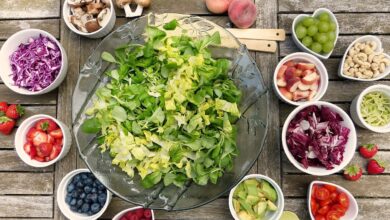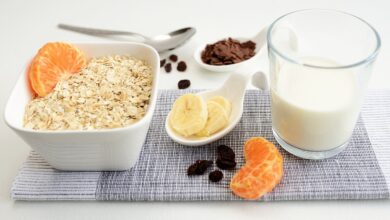
Healthy eating is fundamental to maintaining good health and well-being. A balanced diet provides the necessary nutrients your body needs to function effectively. This comprehensive guide explores what constitutes healthy food, detailing the various food groups, their benefits, and how to incorporate them into your daily diet.
Understanding Healthy Food
Healthy food is defined as foods that provide essential nutrients such as vitamins, minerals, proteins, carbohydrates, and fats that our bodies need to function correctly. These foods are minimally processed and come from natural sources.
Key Components of Healthy Food
- Nutrient Density: Foods that are high in vitamins and minerals relative to their calorie content.
- Whole Foods: Minimally processed and free from artificial ingredients.
- Balance and Variety: Incorporating a wide range of foods to ensure all nutrient needs are met.
The Major Food Groups
1. Fruits and Vegetables
Fruits and vegetables are cornerstones of a healthy diet. They are rich in essential vitamins, minerals, fiber, and antioxidants.
Benefits
- Vitamins and Minerals: Provide necessary nutrients for body functions.
- Fiber: Aids in digestion and promotes a healthy gut.
- Antioxidants: Protect cells from damage and reduce inflammation.
Examples
- Fruits: Apples, bananas, berries, oranges, and grapes.
- Vegetables: Leafy greens (spinach, kale), cruciferous vegetables (broccoli, cauliflower), and root vegetables (carrots, sweet potatoes).
2. Whole Grains
Whole grains are a crucial source of complex carbohydrates, fiber, and essential nutrients like B vitamins and iron.
Benefits
- Energy: Provide a steady source of energy.
- Fiber: Helps with digestion and can lower cholesterol levels.
- Nutrient-Rich: Contain more nutrients than refined grains.
Examples
- Brown rice, quinoa, whole wheat bread, oats, and barley.
3. Proteins
Proteins are vital for building and repairing tissues, making enzymes, and supporting immune function.
Benefits
- Muscle Repair and Growth: Essential for muscle development and repair.
- Enzyme Production: Crucial for metabolic processes.
- Immune Support: Important for a healthy immune system.
Examples
- Animal Proteins: Lean meats (chicken, turkey), fish, eggs, and dairy products.
- Plant Proteins: Beans, lentils, tofu, tempeh, and nuts.
4. Dairy and Dairy Alternatives
Dairy products and fortified alternatives provide calcium, vitamin D, and protein, which are essential for bone health.
Benefits
- Bone Health: Rich in calcium and vitamin D, which are critical for maintaining strong bones.
- Protein: Supports muscle repair and growth.
- Probiotics: Found in yogurt, which can aid in digestive health.
Examples
- Dairy: Milk, yogurt, cheese.
- Alternatives: Almond milk, soy milk, and fortified plant-based yogurts.
5. Healthy Fats
Healthy fats are essential for brain health, energy, and the absorption of certain vitamins.
Benefits
- Brain Health: Essential fatty acids like omega-3s support cognitive function.
- Energy: Provide a concentrated source of energy.
- Vitamin Absorption: Aid in the absorption of fat-soluble vitamins (A, D, E, and K).
Examples
- Monounsaturated Fats: Olive oil, avocados, and nuts.
- Polyunsaturated Fats: Fatty fish (salmon, mackerel), flaxseeds, and walnuts.
6. Hydration
Staying hydrated is crucial for overall health. Water is essential for digestion, nutrient transport, and temperature regulation.
Benefits
- Digestion: Aids in the breakdown and absorption of nutrients.
- Temperature Regulation: Helps maintain body temperature.
- Nutrient Transport: Assists in transporting nutrients throughout the body.
Examples
- Water: The best source of hydration.
- Other Beverages: Herbal teas, and water-rich fruits and vegetables (cucumbers, watermelon).
Tips for Eating Healthy
1. Balance and Moderation
Balance your meals to include a variety of food groups and practice moderation to avoid overconsumption of any single nutrient.
2. Portion Control
Be mindful of portion sizes to maintain a healthy weight and avoid overeating.
3. Plan Your Meals
Planning meals ahead can help ensure a balanced diet and prevent reliance on unhealthy, convenience foods.
4. Cook at Home
Preparing meals at home allows you to control the ingredients and cooking methods, leading to healthier eating.
5. Read Food Labels
Understanding food labels can help you make informed choices about what you’re eating, particularly in terms of added sugars, fats, and sodium.
6. Limit Processed Foods
Processed foods often contain unhealthy additives, high levels of sugar, salt, and unhealthy fats. Opt for whole, natural foods whenever possible.
7. Stay Hydrated
Drink plenty of water throughout the day to support overall health and well-being.
Sample Healthy Meal Plan
Breakfast
- Option 1: Greek yogurt topped with fresh berries, chia seeds, and a drizzle of honey.
- Option 2: Oatmeal with sliced bananas, walnuts, and a sprinkle of cinnamon.
Mid-Morning Snack
- Option 1: An apple with a handful of almonds.
- Option 2: Carrot sticks with hummus.
Lunch
- Option 1: Grilled chicken salad with mixed greens, cherry tomatoes, cucumbers, and a vinaigrette dressing.
- Option 2: Quinoa bowl with black beans, avocado, corn, and a lime-cilantro dressing.
Afternoon Snack
- Option 1: Low-fat Greek yogurt with a sprinkle of flaxseeds.
- Option 2: A small pear with a slice of low-fat cheese.
Dinner
- Option 1: Baked salmon with steamed broccoli and a side of brown rice.
- Option 2: Stir-fried tofu with mixed vegetables (bell peppers, snap peas, carrots) over quinoa.
Evening Snack
- Option 1: A small bowl of mixed berries.
- Option 2: A few whole-grain crackers with a slice of low-fat turkey breast.
Healthy eating is about consuming a balanced diet rich in nutrients, encompassing a variety of food groups. By focusing on nutrient-dense whole foods, including fruits, vegetables, whole grains, proteins, dairy or alternatives, healthy fats, and staying hydrated, you can support overall health and well-being. Practicing moderation, planning meals, cooking at home, reading food labels, and limiting processed foods are practical steps toward maintaining a healthy diet. Remember, healthy eating is not about strict limitations but rather about feeling great, having more energy, and improving your health.




